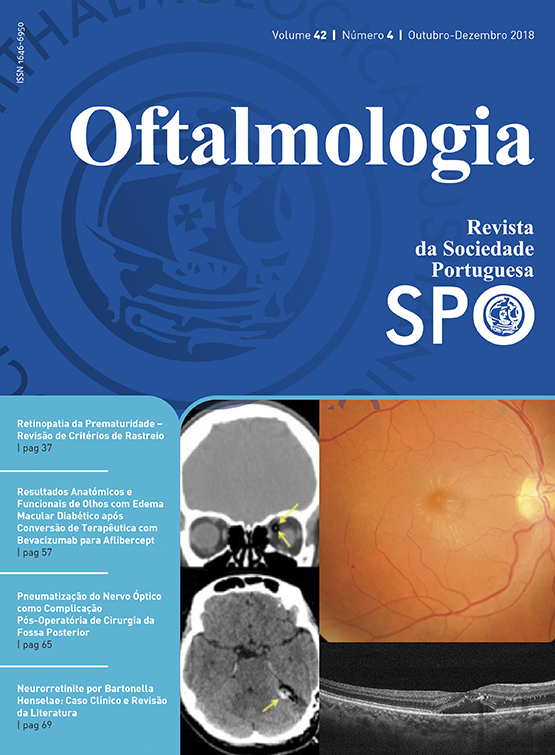Advanced Glaucoma - Keeping the light at the end of the tunnel
DOI:
https://doi.org/10.48560/rspo.13347Keywords:
trabeculectomia, esclerectomia profunda não penetrante, glaucoma avançado, eficácia, qualidade de vida, trabeculectomy, non-penetrating deep sclerectomy, advanced glaucoma, efficacy, quality of life.Abstract
Objetivo: Avaliar a eficácia e segurança da trabeculectomia e esclerectomia profunda não penetrante (EPNP) em olhos com glaucoma avançado.
Material e Métodos: Foram revistos os casos de glaucoma avançado submetidos a cirurgia entre janeiro de 2015 e maio de 2017. O sucesso absoluto foi definido como pressão intraocular (PIO) no pós operatório <18 mmHg sem aplicação de fármacos hipotensores oculares (FHO) e o sucesso qualificado como PIO no pós operatório <18 mmHg com ou sem colocação FHO.
Resultados: 52 olhos foram submetidos a cirurgia de glaucoma (34 realizaram EPNP e 18 trabeculectomia). O tempo médio de follow-up foi de 16,2 meses. 76,9% dos procedimentos foram combinados com cirurgia de catarata. Atingiu-se o sucesso absoluto em 82.7% dos casos e o sucesso qualificado em 96,2%. A PIO média pré e pós cirurgia foi 22,24 e 11,93 mmHg, respetivamente. O número médio de FHO pré cirúrgico foi 2,13 e o pós cirúrgico 0,25. A acuidade visual média pré cirúrgica foi 0.42logMAR e a pós cirúrgica 0.22 logMAR. No pós operatório registaram-se 7 casos de hipotonia precoce, um de descolamento coroideu e dois de quistos da ampola. 5 pacientes realizaram goniopunção e dois trabeculoplastia laser seletiva para controlo da PIO.
Conclusões: A EPNP e a trabeculectomia foram eficazes no tratamento de pacientes com glaucoma avançado. Registou-se uma baixa taxa de complicações, não se verificando diminuição da acuidade visual em nenhum dos casos. O controlo da PIO sem FHO está associado a uma melhoria da qualidade de vida e menores flutuações da PIO, aspetos fundamentais para estes pacientes.
Purpose: To evaluate the efficacy and safety of trabeculectomy and non-penetrating deep sclerectomy (NPDS) in eyes with advanced glaucoma.
Material and Methods: Retrospective review of patients with advanced glaucoma submitted to surgery between January 2015 and May 2017. Absolute success was defined as postoperative intraocular pressure (IOP) <18 mmHg without application of hypotensive medications and qualified success as postoperative IOP <18 mmHg with or without hypotensive medications.
Results: 52 eyes were submitted to glaucoma surgery (34 NPDS and 18 trabeculectomy). The mean follow-up time was 16.2 months. 76.9% of the procedures were combined with cataract surgery.The absolute success was achieved in 82.7% of the cases and the qualified success in 96.2%. The mean IOP pre and postoperative was 22.24 and 11.93 mmHg, respectively. The mean number of preoperative hypotensive medications was 2.13 and the postoperative 0.25. The mean preoperative visual acuity was 0.42logMAR and the postoperative 0.22 logMAR. In the postoperative period, 7 cases of early hypotony, one of choroidal detachment and two of bleb cysts were recorded. Five patients required goniopuncture and two selective laser trabeculoplasty for IOP control.
Conclusions: NPDS and trabeculectomy were effective in the treatment of patients with advanced glaucoma. There was a low rate of complications, and no cases of visual acuity decrease during the follow-up period. Control of IOP without hypotensive medications is associated with an improvement in quality of life and lower IOP fluctuations, which are crucial aspects for these patients.
Downloads
Downloads
Published
How to Cite
Issue
Section
License
Do not forget to download the Authorship responsibility statement/Authorization for Publication and Conflict of Interest.
The article can only be submitted with these two documents.
To obtain the Authorship responsibility statement/Authorization for Publication file, click here.
To obtain the Conflict of Interest file (ICMJE template), click here





